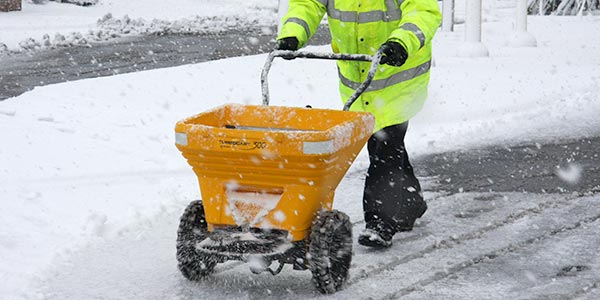
When it comes to ensuring your site is clear of ice and snow hazards, the reliability and performance of your grit spreader is essential.
At Glasdon, we're here to help.
Read on for all you need to know about effectively maintaining your grit spreader over the winter months, as well as further information on our extensive Turbocast Servicing Packages.
Maintenance Tips:
As well as ensuring an adequate supply of grit salt or ice melt is at your disposal, and that grit bins are conveniently located in order to maximise coverage, keeping your grit spreader in prime condition is key to ensuring its optimum performance, when you need it most!
Here are a few top tips to make sure you’re not caught out this winter...
1) After using your grit spreader, it's important to make sure that no excess grit remains in the machine before storing away – especially if it isn’t going to be needed for a while. This is mainly due to the fact that salt is hygroscopic (absorbs water), and if left at the bottom of your grit spreader, it can set like concrete. Additionally, if you try to wheel the gritter with old salt still in the gritting mechanisms, it is likely to cause further damage.
2) Before each outing, ensure all fittings are secure, and tighten if necessary. Lubricating any moving parts with grease, WD40, or similar, is also a good idea.
3) Rock salt is extremely corrosive, known to rapidly rust through bare metal. Therefore, it’s important to touch up any dents or scratches to the metalwork of your gritter with a “Hammerite” type paint, thus helping prevent any rusting or erosion. This is why the metal components on Glasdon grit spreaders are treated with an Armortec™️ Coating, for maximum protection.
4) Consider Glasdon IceMelt™ as an alternative to traditional rock salt/grit. Our highly effective formula works faster than rock salt, has less of an impact on the environment, and provides a longer lasting solution in severe conditions. Furthermore, ice melt is considerably less corrosive, and unlike grit, leaves behind very little residue. Find out more via our handy ice melt vs rock salt FAQ.
Glasdon Support:
At Glasdon, we provide you with detailed information about your hand spreader, or your towable spreader, in order for you to better understand exactly how it operates. This can be vitally important if anything were to go wrong with your product, as our information brochures can help locate the problem, and identify the solution.
Additionally, we create helpful video guides, so you know exactly how to keep your grit spreader running.
In the below video, you can see how to replace the spinner drive belt on a Turbocast 300™ Grit Salt Broadcast Spreader, in just a few simple steps.
If anything does go wrong with your manual or towable gritter this winter, don’t panic! We have experts on hand who can help diagnose the problem, and we keep a large supply of spares in our warehouse, that can be dispatched immediately, to help keep your site free of ice and snow hazards.
To find out more, call us on 1800 656 606, or live chat with us online today. We look forward to hearing from you!
Alternatively, visit our online winter safety store for further information on any of our winter safety tips or grit spreaders.




